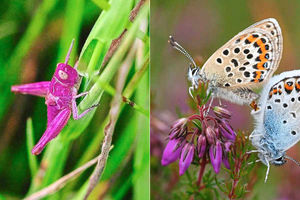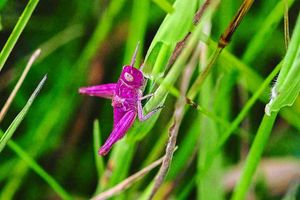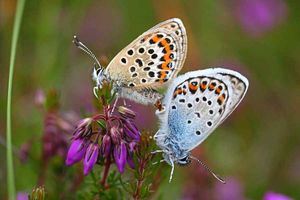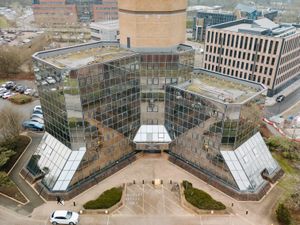Ahh grasshopper: Shropshire wildlife spotters in the pink after a rare find
They look like they belong in an exotic rain forest – but these are just two examples of some of the rare and endangered wildlife that can be spotted here in Shropshire.


A pink grasshopper and silver-studded blue butterflies are just the latest of a long line of colourful wildlife that call Prees Heath Common Reserve, near Whitchurch, their home.
The very unusual vivid pink grasshopper was spotted by keen wildlife photographer John Harding at the reserve this week.
He said: "I was at the reserve to film the silver-studded blue butterflies when we noticed a strange looking insect in the grass.
"It was a very vivid pink colour and certainly stood out."

Experts at Shropshire Wildlife Trust said the insect was thought to be a young female meadow grasshopper.
Grasshoppers are usually green, brown or a combination of the two, so they can blend into their background.
It is thought that the colours of pink grasshoppers may be caused by a genetic mutation, similar to that which affects albino animals.
Unfortunately their vibrant colour means they rarely survive to adulthood as they are easily spotted and eaten by predators and so are extremely rare.
Meanwhile a total of 2,954 silver-studded blue butterflies were counted during a conservation exercise at the reserve on Wednesday.
The creature is almost entirely confined to heathland areas and has become a symbol for the fast diminishing habitat.
Prees Heath Common is the last remaining place in the Midlands where this particular species of butterfly survives.
Ten volunteers counted for three hours, making sure they did not count the same butterfly twice.
Stephen Lewis, Prees Heath warden, said he was pleased with the results.
He said: "We are very pleased with the result, especially as we counted more silver-studded blues on the areas we began restoring to heathland 10 years ago. The butterfly has a strong association with ants over all four stages of its life cycle, to the extent that unless ants' nests are present in good numbers there will be no butterflies on the heath.
"Heathland is a habitat that has been widely destroyed over the past 200 years, and that is why the surviving heathland at Prees Heath Common is the last sanctuary for the silver-studded blue in the whole of the Midlands."
The silver-studded blue gets its name from the light blue reflective scales found on the underside of most adults and which are visible when light reflects off them. As with many other species of blue, the males are blue while the female is a less-conspicuous brown.
The silver-studded blue is found in close-knit colonies, which makes it good for butterfly-spotters.
They rarely fly any distance. Most colonies contain fewer than a thousand adults.
However, a few colonies are huge, with the number of adults measured in tens of thousands, providing an amazing spectacle.





